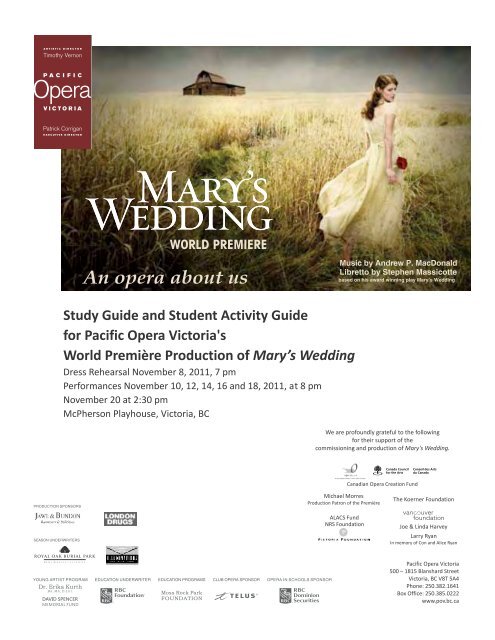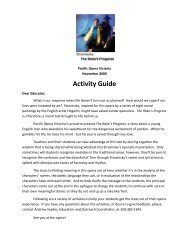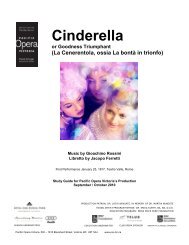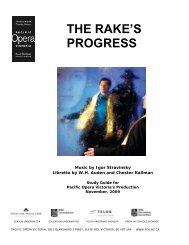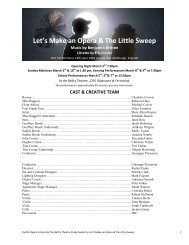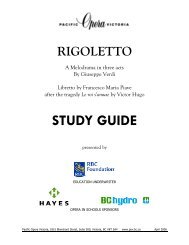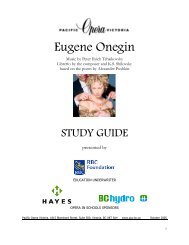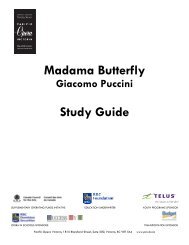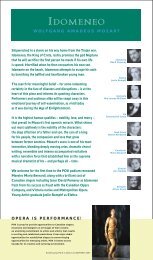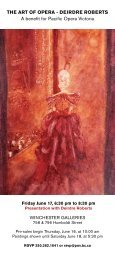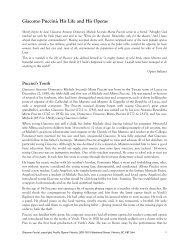Mary's Wedding Study and Activity Guide - Pacific Opera Victoria
Mary's Wedding Study and Activity Guide - Pacific Opera Victoria
Mary's Wedding Study and Activity Guide - Pacific Opera Victoria
You also want an ePaper? Increase the reach of your titles
YUMPU automatically turns print PDFs into web optimized ePapers that Google loves.
P RODUCTION SPONSORS<br />
SEASON UNDERWRITERS<br />
YOUNG ARTIST PROGRAM<br />
Dr. Erika Kurth<br />
BA, M A, D.Lit t.<br />
DAVID SPENCER<br />
MEMORIAL FUND<br />
An opera about us<br />
<strong>Study</strong> <strong>Guide</strong> <strong>and</strong> Student <strong>Activity</strong> <strong>Guide</strong><br />
for <strong>Pacific</strong> <strong>Opera</strong> <strong>Victoria</strong>'s<br />
World Première Production of Mary’s <strong>Wedding</strong><br />
Dress Rehearsal November 8, 2011, 7 pm<br />
Performances November 10, 12, 14, 16 <strong>and</strong> 18, 2011, at 8 pm<br />
November 20 at 2:30 pm<br />
McPherson Playhouse, <strong>Victoria</strong>, BC<br />
EDUCATION UNDERWRITER EDUCATION PROGRAMS CLUB OPERA SPONSOR<br />
Moss Rock Park<br />
FOUNDATION<br />
OPERA IN SCHOOLS SPONSOR<br />
Music by Andrew P. MacDonald<br />
Libretto by Stephen Massicotte<br />
based on his award winning play Mary’s <strong>Wedding</strong><br />
We are profoundly grateful to the following<br />
for their support of the<br />
commissioning <strong>and</strong> production of <strong>Mary's</strong> <strong>Wedding</strong>.<br />
Michael Morres<br />
Production Patron of the Première<br />
ALACS Fund<br />
NRS Foundation<br />
Canadian <strong>Opera</strong> Creation Fund<br />
The Koerner Foundation<br />
Joe & Linda Harvey<br />
Larry Ryan<br />
In memory of Con <strong>and</strong> Alice Ryan<br />
<strong>Pacific</strong> <strong>Opera</strong> <strong>Victoria</strong><br />
500 – 1815 Blanshard Street<br />
<strong>Victoria</strong>, BC V8T 5A4<br />
Phone: 250.382.1641<br />
Box Office: 250.385.0222<br />
www.pov.bc.ca
<strong>Pacific</strong> <strong>Opera</strong> <strong>Victoria</strong><br />
November, 2011<br />
<strong>Study</strong> & <strong>Activity</strong> <strong>Guide</strong><br />
Dear Educator,<br />
<strong>Pacific</strong> <strong>Opera</strong> <strong>Victoria</strong> is proud to present the World Premiere of Mary’s <strong>Wedding</strong>. This<br />
<strong>Activity</strong> <strong>Guide</strong> was prepared to help your students get even more out of their opera<br />
experience.<br />
Check out our website at http://www.pov.bc.ca/maryswedding.html for inside information<br />
about Mary’s <strong>Wedding</strong>. Please suggest that your students take advantage of our website.<br />
The more your students know about the production, the more they will enjoy it!<br />
See you at the opera!<br />
Jackie Adamthwaite<br />
Manager of Artistic Programs
How to enjoy the show <strong>and</strong> be a great<br />
<strong>Opera</strong> Audience Member!<br />
Before the show:<br />
-Eat before you come to the theatre. There is no food allowed in the Auditorium.<br />
-Arrive on Time! Quite often we do not seat latecomers <strong>and</strong> you may have to watch<br />
the first-half of the show on one on the lobby TVs.<br />
-Check to see how long the opera is; plan your trip to the bathroom.<br />
-Read the story; the program includes the Synopsis <strong>and</strong> the Director’s Notes.<br />
-Turn your cell phone off – along with anything else that beeps or makes noise.<br />
During the show:<br />
-Don’t talk to your friends. The theatre is designed to carry sound from the stage to<br />
the audience <strong>and</strong> back. Remember, this isn’t a Movie, the singers can hear you!<br />
-No eating, or drinking during the performance.<br />
-No cameras or recording devices of any kind can be used in the theatre.<br />
-Please, no feet on seats or railings.<br />
-No shouting or yelling out.<br />
At the end of the show:<br />
-Clap as much as you like <strong>and</strong> yell “Bravo” at your favourite singers!<br />
-You can even give a St<strong>and</strong>ing Ovation if you really enjoyed the show!
<strong>Opera</strong> Singers<br />
What? No microphones?!<br />
<strong>Opera</strong> singers make themselves heard through the whole house, over a full orchestra – without amplification.<br />
There are no microphones hidden in the set! Instead, opera singers use their training <strong>and</strong> the acoustics of the<br />
theatre to project their voices. In order to do this, opera singers train for longer than doctors. This is partly<br />
because they are trying to isolate <strong>and</strong> train their vocal cords: a mechanism about the size of your little finger<br />
nail. This is made doubly hard by the fact that unlike other musicians, singers can’t see their instrument, so all<br />
of their learning has to be by sensation.<br />
Amazing feats of memory!<br />
<strong>Opera</strong> singers have to memorize several hours of music for each opera. <strong>Opera</strong>s are usually performed in the<br />
language in which they were written, which means that opera singers must perform in – <strong>and</strong> underst<strong>and</strong> –<br />
Italian, German, French, Russian; even Czech!<br />
Phew!<br />
<strong>Opera</strong> singers do all of these things while they are onstage under hot lights, performing blocking that can be<br />
awkward or difficult. <strong>Opera</strong> singers have to be able to sing lying down, running, jumping, dancing <strong>and</strong><br />
performing all kinds of other tricky moves. Period costumes like hoop skirts, cloaks <strong>and</strong> corsets <strong>and</strong> wigs can<br />
also be hot <strong>and</strong> uncomfortable.<br />
Who sings what?<br />
Here is a very rough guide to the different voice types, starting with the highest (soprano), going right down to<br />
the very deepest (bass).<br />
Soprano: Sopranos have the highest voices. They usually play the heroines of an opera. This means they have<br />
lots of show-off arias to sing, <strong>and</strong> get to fall in love <strong>and</strong> / or die more often than other female voice types.<br />
Mezzo-soprano, or mezzo: This is the middle female voice, <strong>and</strong> has a darker, warmer sound than the soprano.<br />
Mezzos spend a lot of their time playing mothers <strong>and</strong> villainesses, although sometimes they get to play<br />
seductive heroines. Mezzos also play young men on occasion – these are called trouser roles, for obvious<br />
reasons.<br />
Contralto, or alto: The lowest female voice. Contralto is a rare voice type. Altos usually portray older females<br />
or character parts like witches <strong>and</strong> old gypsies.<br />
Counter tenor: Also known as alto, this is the highest male voice, <strong>and</strong> another vocal rarity. Counter tenors sing<br />
with about the same range as a contralto. Counter tenor roles are most common in baroque opera, but some<br />
more modern composers write parts for counter tenors too.<br />
Tenor: If there are no counter tenors on stage, then the highest male voice in opera is tenor. Tenors are usually<br />
the heroes who get the girl or die horribly in the attempt.<br />
Baritone: The middle male voice. In comic opera, the baritone is often the ringleader of whatever naughtiness<br />
is going on, but in tragic opera, he’s more likely to play the villain.<br />
Bass: The lowest male voice. Low voices usually suggest age <strong>and</strong> wisdom in serious opera, <strong>and</strong> basses usually<br />
play Kings, fathers, <strong>and</strong> gr<strong>and</strong>fathers. In comic opera basses often portray old characters that are foolish or<br />
laughable.<br />
From the Metropolitan <strong>Opera</strong> Guild, Education Department
Mary’s <strong>Wedding</strong><br />
Music by Andrew P. MacDonald<br />
Libretto by Stephen Massicotte, based on his play Mary’s <strong>Wedding</strong>.<br />
November 10, 12, 14, 16, 18, 2011, at 8 pm<br />
Matinée November 20 at 2:30 pm<br />
At the McPherson Playhouse<br />
In English with English Surtitles<br />
The performance will be given in two acts with one intermission,<br />
with a total running time of two hours <strong>and</strong> 50 minutes.<br />
CAST & CREATIVE TEAM<br />
Charlie Edwards<br />
a rugged Canadian farm boy ............................................ Thomas Macleay<br />
Mary Chalmers<br />
a young lady recently arrived in Canada from Engl<strong>and</strong> ..... Betty Waynne Allison<br />
Gordon Muriel Flowerdew (Flowers)<br />
a sergeant promoted to lieutenant ..................................... Alain Coulombe<br />
Canadian townspeople, workmen, Mary’s mother, soldiers, an officer, wedding<br />
guests<br />
Conductor ............................................................................. Timothy Vernon<br />
Director ................................................................................. Michael Shamata<br />
Set <strong>and</strong> Costume Designer ..................................................... Ian Rye<br />
Costume Design Associate ..................................................... Nancy Bryant<br />
Design Assistant ..................................................................... Nathan Brown<br />
Lighting Designer ................................................................... Alan Brodie<br />
Fight Director ......................................................................... Nicholas Harrison<br />
Stage Manager ....................................................................... Sara Robb<br />
Assistant Stage Managers ....................................................... S<strong>and</strong>y Halliday,<br />
Nicole Olszewski<br />
Principal Coach & Répétiteur ................................................. Robert Holliston<br />
Chorus Master & Assistant to the Artistic Director .................. Giuseppe Pietraroia<br />
Assistant Accompanist ........................................................... Kim Cousineau<br />
With the <strong>Victoria</strong> Symphony, the POV Chorus, <strong>and</strong> the <strong>Victoria</strong> Choral Society<br />
Note: Strobe lights will be used during the performance.<br />
This production of <strong>Mary's</strong> <strong>Wedding</strong> is being recorded by CBC Radio 2 for future<br />
broadcast on Saturday Afternoon at the <strong>Opera</strong> with host Bill Richardson
Background of the New <strong>Opera</strong> Mary’s <strong>Wedding</strong><br />
In 2008 <strong>Pacific</strong> <strong>Opera</strong> <strong>Victoria</strong> commissioned composer Andrew MacDonald <strong>and</strong> playwright Stephen<br />
Massicotte to develop an opera from Stephen's award-winning play, <strong>Mary's</strong> <strong>Wedding</strong>.<br />
Three years later, this new Canadian opera is about to make its world première, <strong>and</strong> we at POV are<br />
proud <strong>and</strong> exhilarated to share it with our community, for <strong>Mary's</strong> <strong>Wedding</strong> is very much an opera about<br />
us – about our history, our l<strong>and</strong>scape, <strong>and</strong> our memories.<br />
In the decade since its première at Alberta Theatre Projects playRites Festival, the play <strong>Mary's</strong> <strong>Wedding</strong><br />
has seen many performances across North America <strong>and</strong> in the UK, including a 2002 co-production<br />
between <strong>Victoria</strong>'s Belfry Theatre <strong>and</strong> the Vancouver Playhouse. One of the most successful Canadian<br />
plays of the 21st century, it has a strongly Canadian setting, yet the story is universal.<br />
Stephen Massicotte has now transformed his play into an opera libretto, in collaboration with composer<br />
Andrew MacDonald, who has built on the poetry of the play <strong>and</strong> its non-linear structure to create a<br />
world where reality <strong>and</strong> dream merge into a singular musical l<strong>and</strong>scape.<br />
The final work is astonishingly operatic. Words <strong>and</strong> music conspire to create an experience that is<br />
compelling, dramatic, <strong>and</strong> very moving.<br />
At every step over the opera’s three-year gestation, Stephen <strong>and</strong> Andrew have been supported by a<br />
committed team from POV, beginning with Executive Directors David Shefsiek <strong>and</strong> Patrick Corrigan,<br />
who coordinated artistic <strong>and</strong> financial aspects of the project.<br />
POV’s artistic <strong>and</strong> production team shepherded the new opera through a series of workshops in <strong>Victoria</strong>,<br />
Banff, <strong>and</strong> Toronto, that let the creators hear excerpts performed by piano, by orchestra, <strong>and</strong> by soloists<br />
<strong>and</strong> a small chorus. Last June, a final staging workshop allowed additional fine tuning of details of timing<br />
<strong>and</strong> staging.<br />
The workshops helped the creators to refine the opera, aided by the astute observations of the creative<br />
team – POV Artistic Director <strong>and</strong> Conductor Timothy Vernon; Michael Shamata, dramaturge for the<br />
project <strong>and</strong> director of the production; <strong>and</strong> Ian Rye, POV's Director of Artistic Administration, <strong>and</strong><br />
designer of the sets <strong>and</strong> costumes.<br />
A happy outcome of the workshop process was the fact that the three soloists engaged to perform during<br />
the workshops made an immediate impact. Their voices, their suitability to the roles, <strong>and</strong> their emotional<br />
intensity left us in no doubt: we were thrilled to engage all three for the world première production:<br />
Betty Waynne Allison as Mary; Thomas Macleay as Charlie, <strong>and</strong> Alain Coulombe as Sgt. Flowerdew.<br />
A singer who performs the world première of a role is often said to have created the role. Certainly this<br />
can be said of Betty, Thomas, <strong>and</strong> Alain, whose involvement throughout the creation process allowed<br />
them not only to learn the opera in depth, but to contribute in very real ways to its final shape <strong>and</strong><br />
sound.<br />
Also important to the success of the workshops were soprano Robyn Driedger-Klassen, who filled in<br />
beautifully for Betty at some sessions; coaches Robert Holliston <strong>and</strong> Teresa Turgeon; conductor Joey<br />
Pietraroia; pianist Kim Cousineau, the <strong>Victoria</strong> Symphony, <strong>and</strong> a host of POV choristers, including Kristy<br />
Gislason, Tamara Rusque, <strong>and</strong> Sam Marcaccini, who have sung the chorus for virtually every workshop.<br />
At first blush, opera creation in the 21st century, with its long, carefully planned trajectory, <strong>and</strong><br />
workshops <strong>and</strong> review at every stage, is quite unlike the way it worked in the first 400 or so years of<br />
opera. Yet in some ways it is very similar.<br />
While we don’t hear of Mozart or Verdi workshopping their operas, they did write with specific singers<br />
in mind. And if you aren’t churning out opera after opera (full-time opera composers being an<br />
endangered species these days), the next best way to grasp the subtleties <strong>and</strong> colours of a singer’s voice<br />
<strong>and</strong> to learn how your finished work will sound is through the workshop process.
Background of the New <strong>Opera</strong> Mary’s <strong>Wedding</strong> continued<br />
The three years spent on Mary’s <strong>Wedding</strong> may seem a prolonged labour when we remember that Rossini<br />
dashed off The Barber of Seville in around three weeks <strong>and</strong> repeated the feat with Cinderella. However,<br />
most opera composers held to a more sedate pace than Rossini: Madama Butterfly, La Bohème, <strong>and</strong><br />
Manon Lescaut each took Puccini about three years from pen to production (<strong>and</strong> writing Manon Lescaut<br />
burned through some seven librettists <strong>and</strong> uncounted tantrums).<br />
Mary’s <strong>Wedding</strong> – as with many operas today – has come out of a collaborative process. There’s no<br />
composer browbeating a succession of librettists à la Puccini or autocratically writing the whole<br />
shebang – music, words, <strong>and</strong> exhaustive stage directions – as Wagner did.<br />
<strong>Opera</strong>s often used to be cranked out like episodes of a television series. They were creatures of fashion<br />
<strong>and</strong> weren't expected to have a life into the next year or the next century. While many have lasted, many<br />
more are long forgotten.<br />
We want this one to last. As with most operas, the process of creating Mary’s <strong>Wedding</strong> has had its own<br />
rhythm <strong>and</strong> challenges. It represents a major – <strong>and</strong>, we believe, rewarding – investment of time, talent,<br />
<strong>and</strong> care.<br />
Funding a new opera, like most performing arts activities today, requires a complex process of grant<br />
writing <strong>and</strong> engaging supportive donors in the project. POV is particularly grateful to the organizations<br />
<strong>and</strong> individuals who have shown their faith in this new opera through their generous financial<br />
commitments.<br />
And we are deeply thankful to our patrons <strong>and</strong> audience, who have supported our growth <strong>and</strong> made
Synopsis<br />
The setting is Saskatchewan, two years after the end of World War I.<br />
On the night before her wedding, Mary Chalmers dreams of her first love, Charlie<br />
Edwards.<br />
She dreams of their first meeting as they take shelter from a prairie thunderstorm <strong>and</strong><br />
Charlie gives her a ride home on his horse. Their shy love grows, even as Mary’s English<br />
mother disapproves of the “dirty farm boy” as a match for her daughter.<br />
When war is declared, Charlie joins C Squadron of Lord Strathcona’s Horse Regiment<br />
<strong>and</strong> sails for Engl<strong>and</strong>. In his letters, he tells Mary of meeting the King of Engl<strong>and</strong>, of<br />
volunteering to go over to France after the Second Battle of Ypres, in which the Germans<br />
first used chlorine gas as a weapon. He tells of his sympathetic Sergeant, Gordon Muriel<br />
Flowerdew (Flowers) <strong>and</strong> recounts his life as a soldier – the trenches, the lice, the mud,<br />
the thunder of artillery, <strong>and</strong> the terrible battle of Moreuil Wood in which Flowerdew, now<br />
a Lieutenant, leads his squadron against the German machine guns.<br />
The fictional lives of the young lovers in the opera are intertwined with historical events<br />
<strong>and</strong> with the real-life character of Lieutenant Gordon Flowerdew, an Englishman who<br />
had emigrated to Canada <strong>and</strong> settled in Walhachin, BC. Flowerdew returned to Europe<br />
to serve in the Great War with Lord Strathcona’s Horse. In the 1918 battle of Moreuil<br />
Wood, Flowerdew carried out one of the last great cavalry assaults in history, leading a<br />
squadron of Lord Strathcona’s Horse, armed with sabres, against German rifles <strong>and</strong><br />
machine guns. The Canadians helped to stop the German offensive, but at enormous<br />
cost. Flowerdew himself died from his wounds <strong>and</strong> was posthumously awarded the<br />
<strong>Victoria</strong> Cross.
Some Thoughts on Mary’s <strong>Wedding</strong> by: Andrew Paul MacDonald, Composer<br />
I started composing Mary’s <strong>Wedding</strong> almost three years ago. I received a call from Timothy Vernon inviting<br />
me to write an opera for POV <strong>and</strong> to think about a subject. Busy working away at another piece, I had<br />
barely enough time to consider his proposal before he called back asking me what I thought of Stephen<br />
Massicotte’s Mary’s <strong>Wedding</strong>. I told him that although I wasn’t familiar with it I was intrigued by his<br />
enthusiasm <strong>and</strong> that I’d like to see the script right away. I read the play, over <strong>and</strong> over, <strong>and</strong> just fell in love<br />
with Mary, Charlie <strong>and</strong> Flowers. Then a funny thing happened. Lines from the play suddenly popped into<br />
my head as tunes <strong>and</strong> the music just started flowing onto my page. Couldn’t stop it. I think maybe it was<br />
the simple, poetic nature of Stephen’s lines—the rhythms, the unforced quality of the sounds—that lent<br />
themselves so perfectly to my melodies. It was the ideas themselves, too. Sentiments which were worth<br />
setting to music.<br />
It wasn’t the kind of story that I was at first considering for an opera, but I soon discovered that it was a<br />
perfect story for my musical imagination. I wanted something surreal where it would seem normal that<br />
people sing to each other. What better setting for that than Mary’s dream world? Often I’ve experienced<br />
dreams where all the inhabitants converse in song. Perfectly normal! A dream can be a chaotic place, too,<br />
but one in which profound things may come to the surface. Transforming this non-linear dream story into<br />
an opera was a challenging undertaking that couldn’t have been achieved without the remarkable vision of<br />
Michael Shamata who acted as dramaturge throughout the workshop process.<br />
I decided on three distinct musical voices for the character triangle that Stephen had originally created<br />
with two actors. He had cleverly combined Mary <strong>and</strong> Flowers into the female lead <strong>and</strong> infused each with a<br />
similar affection for Charlie. I decided to explore this further by separating this dual role into a soprano <strong>and</strong><br />
bass for reasons of musical variety <strong>and</strong> to connect them through shared musical material. What resulted<br />
were two distinct personalities who each care deeply for Charlie <strong>and</strong> make him more real in the process.<br />
All three sing real arias—I think some of the tunes may stick with you. Remember the words, too. They’re<br />
important. I also wanted to exp<strong>and</strong> the vocal forces so as to include a chorus that would function as<br />
characters that are mentioned in the play, but could now have a voice. So the townspeople, workmen,<br />
mothers <strong>and</strong> children, tea party guests <strong>and</strong>, of course, the soldiers all come to life through the chorus,<br />
which also functions omnisciently as in Greek tragedy.<br />
The arias, duets <strong>and</strong> choral numbers are embedded in a large-scale musical l<strong>and</strong>scape divided into two<br />
acts. Both acts are formed of continuous music where one scene leads directly into the next, similar to the<br />
dream-like way the play itself unfolds. Although many musical themes wind their way through the opera, it<br />
is the love theme, a never-ending pentatonic melody rising through all the keys, that predominates.<br />
Occurring at a number of key moments, it also forms the foundation for a set of variations that accompany<br />
the dream wedding processional that concludes the work.<br />
Although Mary’s <strong>Wedding</strong> is a tale of love <strong>and</strong> war, it is also about dealing with sadness. Coping with grief<br />
through acceptance, a theme of my first symphony, The Red Guru, is also what makes Stephen’s story so<br />
important. Mary cannot rest from her recurrent dream until she accepts that Charlie is dead. She must do<br />
this if she is to move on <strong>and</strong> marry someone else. Only then will the words “Wake up, Mary, wake up”<br />
have their true meaning.<br />
Many workshops later <strong>and</strong> after many long hours at my desk you have the opera before you. Thanks to all<br />
who have contributed to make this a reality—Stephen, Timothy, Michael, Ian, Jackie, David, Patrick,<br />
Robert, Teresa, Kim, Giuseppe, S<strong>and</strong>y <strong>and</strong> all the singers who participated in the workshops: the POV<br />
chorus, in particular Tamara <strong>and</strong> Sam, <strong>and</strong> especially our soloists Betty, Tom <strong>and</strong> Alain. Special thanks to<br />
my wife Eleanor who copied out my scores <strong>and</strong> parts from the manuscript, then copied my corrections<br />
after what seemed like endless proofreading—a gargantuan task! And to my mom <strong>and</strong> dad who gave me<br />
the inspiration to be a composer; always encouraging, no matter how strange my music sounded. And<br />
finally to all those whose families <strong>and</strong> relationships have been shattered by war, then <strong>and</strong> now. I hope this<br />
work helps to bring some peace.
The Production Design for Mary’s <strong>Wedding</strong><br />
As the only company in Canada to build all its productions, <strong>Pacific</strong> Opea <strong>Victoria</strong> offers eclectic<br />
repertoire choices that offer a unique experience – original, made-in-<strong>Victoria</strong> productions designed<br />
specifically for our audiences.As well, we offer a rare opportunity for Canadian designers to design for<br />
opera by exploring the art form from the ground up rather than re-creating existing productions.<br />
With years of practice in building original productions, POV is ahead of the game when it comes to<br />
creating a new opera from scratch; in fact creating a new opera is a natural extension of what we've<br />
been doing successfully for years.<br />
Ian Rye, POV's Director of Artistic Administration, has overseen our production activities since the<br />
2006/7 season <strong>and</strong> has been part of the development of <strong>Mary's</strong> <strong>Wedding</strong> since it was a gleam in<br />
Timothy Vernon's eye.<br />
Ian has shepherded the opera through the commissioning process, the workshops, <strong>and</strong> now, the final<br />
world première production. An experienced set designer in his own right (you may have seen his sets at<br />
the Belfry Theatre), it is fitting that he is undertaking his first mainstage opera design for POV's first full<br />
commission.<br />
Many stage productions of the play have a barn-like setting which turns h<strong>and</strong>ily into a ship <strong>and</strong> the<br />
trenches at the front. But for the opera, Ian <strong>and</strong> director Michael Shamata have opened up the setting<br />
<strong>and</strong> placed it in a sculptural l<strong>and</strong>scape under wide, beautiful prairie skies that go on forever <strong>and</strong> yet are<br />
as close as can be. Everything actually takes place right here, in <strong>Mary's</strong> back yard, far from the fields of<br />
battle, as she dreams about her first love.<br />
Mary spends the opera in her nightgown. It is 1920; she is about to be married, <strong>and</strong> through the night,<br />
she dreams, remembering the Great War <strong>and</strong> Charlie.<br />
We see the action through the lens of her dream as she imagines the war as described in Charlie's<br />
letters.<br />
When soldiers enter the stage, they are slipping into <strong>Mary's</strong> back yard on a starlit night. Their uniforms<br />
are what <strong>Mary's</strong> imagination has conjured up; <strong>and</strong> the soldiers look just like her neighbours. The chorus<br />
appear as both soldiers <strong>and</strong> neighbours – but those soldiers are her neighbours; every one of them is<br />
someone's brother or cousin or boyfriend.<br />
It's a universal story; it has happened uncounted times. But here it's also very personal.<br />
Ian's design for the opera riffs off the non-linear, dream-like structure of the work. It is a memory play,<br />
the scenes shifting like light, moving like dreams, insubstantial <strong>and</strong> yet anchored in the most truly real<br />
things of all: the human heart <strong>and</strong> the whole wide universe.<br />
Ultimately, it is not the design, but our imagination – <strong>and</strong> <strong>Mary's</strong> dream – that take us to all the other<br />
places in the opera – the ship, the trenches, the embattled forest. The design reinforces the theme of the<br />
play <strong>and</strong> opera: the force of memory <strong>and</strong> imagination, the power of the heart.
The History Behind Mary’s <strong>Wedding</strong><br />
Mary’s <strong>Wedding</strong> highlights the role of the Canadian Regiment known as Lord Strathcona's Horse<br />
(Royal Canadians). The battle described at the end of the opera is a real battle, the Battle of Moreuil<br />
Wood, which took place in 1918. The Battle of Moreuil Wood was one of the last great cavalry<br />
assaults in history. The real Lieutenant Flowerdew led a squadron of Lord Strathcona’s Horse <strong>and</strong><br />
stopped the German advance, marking a turning point in the war.<br />
Following Flowerdew’s death, Marshal Ferdin<strong>and</strong> Foch, supreme comm<strong>and</strong>er of all Allies armies in<br />
Europe during 1918, reportedly commented that Flowerdew’s charge at Moreuil Wood “…possibly<br />
deflected the whole course of history.”<br />
The Strathconas at Moreuil Wood<br />
Robert W. Mackay recounts the true story of Lord Strathcona's Horse <strong>and</strong> the Battle of Moreuil Wood<br />
– a story he knows well, as his own father, Tom Mackay, was in C Squadron at the Battle of Moreuil<br />
Wood. Robert Mackay is the author of the new novel Soldier of the Horse, in which he tells his father's<br />
fictionalized story.<br />
When what later was called the Great War broke out, Canada had two regular force cavalry<br />
regiments, the Royal Canadian Dragoons based in Ontario, <strong>and</strong> Lord Strathcona's Horse (Royal<br />
Canadians) in the west. Originally raised privately by Donald Smith (Lord Strathcona, of CPR fame) for<br />
war in South Africa, the Strathconas were disb<strong>and</strong>ed after the Boer War. The name lived on when it<br />
was adopted by the Canadian army's western cavalry unit before the war began in 1914.<br />
The Strathconas went by ship to Engl<strong>and</strong> along with the rest of the Canadian Expeditionary Force.<br />
St<strong>and</strong>ing by <strong>and</strong> hoping for mounted action, the cavalry trained there until 1915, frustrated because<br />
their brethren in the infantry were already at the front.<br />
Early that year, things went badly for the Canadians in Belgium <strong>and</strong> France, where they were suffering<br />
under relentless artillery, infantry, <strong>and</strong> gas attacks. Responding to a desperate plea for help, the<br />
Canadian Cavalry Brigade left their horses behind in Engl<strong>and</strong> <strong>and</strong> proceeded within days to the<br />
Continent to go to the aid of their comrades.<br />
There followed miserable <strong>and</strong> deadly months in the trenches, until in early 1916 the Brigade was<br />
remounted. Often acting as mounted infantry, the cavalry troopers would spend two weeks at a time<br />
in the trenches, followed by two weeks in reserve, training <strong>and</strong> looking after their own horses <strong>and</strong><br />
those of the other half of the regiment who would then be in the trenches.<br />
That all changed when, on March 21st, 1918, the Germans mounted an all-out effort to finish the war,<br />
pounding the Allies with a monstrous artillery barrage <strong>and</strong> advancing over a forty-mile front. British<br />
<strong>and</strong> French troops were overrun or in retreat. The Canadian Cavalry Brigade, now composed of the<br />
Dragoons, the Strathconas, <strong>and</strong> the Fort Garry Horse, for nine days galloped from one firefight to<br />
another, horses <strong>and</strong> men exhausted <strong>and</strong> hungry. Midnight on March 29th found them encamped two<br />
valleys west of the village of Moreuil in Picardy, France.<br />
“C” Squadron of the Strathconas was led by Lieutenant Gordon Muriel Flowerdew, a one-time<br />
Saskatchewan homesteader <strong>and</strong> Thompson Valley fruit farmer. An English immigrant, Flowerdew had<br />
been an officer in a British Columbia militia regiment. On the outbreak of war he resigned his<br />
commission in order to get into the cavalry, joining the Strathconas as a sergeant. By 1918 he had his<br />
commission back, <strong>and</strong> was one of the regiment's sterling young leaders.
The History Behind Mary’s <strong>Wedding</strong> continued<br />
The officer comm<strong>and</strong>ing the Canadian Cavalry Brigade was John E B Seely, <strong>and</strong> on March 30th, 1918,<br />
under heavy fire, he led his troops to the northwest corner of Moreuil Wood in response to a British plea<br />
to the Canadians to stop or delay the German advance. The Strathconas, Dragoons, <strong>and</strong> Fort Garrys were<br />
flung into a bloody fight in the forest.<br />
Lieutenant Flowerdew led his squadron around the Wood, intending to cut off the escape of the<br />
retreating enemy. Rounding the northeast corner of the wood, his “C” Squadron encountered a double<br />
line of Germans armed with rifles, machineguns, <strong>and</strong> artillery.<br />
Too late to retreat, Flowerdew drew his sword <strong>and</strong> shouted, “It's a charge, boys, it's a charge!” Plunging<br />
forward, many of the troopers were killed; others wounded; <strong>and</strong> a very few escaped death by swerving<br />
into the woods. My father, who was galloping hard on Flowerdew's heels as they pounded toward the<br />
enemy lines, was badly wounded.<br />
Gordon Flowerdew, who died of his wounds the following day, was awarded a posthumous <strong>Victoria</strong><br />
Cross.<br />
The real Lieutenant Flowerdew was among 70 Canadians who served in WWI <strong>and</strong> were awarded the<br />
<strong>Victoria</strong> Cross, the Commonwealth’s highest award for valour.<br />
Here is the citation for Flowerdew’s <strong>Victoria</strong> Cross:<br />
“For most conspicuous bravery <strong>and</strong> dash when in comm<strong>and</strong> of a squadron<br />
detailed for special service of a very important nature. On reaching the first<br />
objective, Lieutenant Flowerdew saw two lines of the enemy, each about<br />
sixty strong, with machine guns in the centre <strong>and</strong> flanks, one line being<br />
about two hundred yards behind the other. Realising the critical nature of<br />
the operation <strong>and</strong> how much depended upon it, Lieutenant Flowerdew<br />
ordered a troop under Lieutenant Harvey, V.C., to dismount <strong>and</strong> carry out a<br />
special movement while he led the remaining three troops to the charge.<br />
The squadron (less one troop) passed over both lines, killing many of the<br />
enemy with the sword; <strong>and</strong> wheeling about galloped at them again.<br />
Although the squadron had then lost about 70 per cent of its numbers, killed<br />
<strong>and</strong> wounded, from rifle <strong>and</strong> machine-gun fire directed on it from the front<br />
<strong>and</strong> both flanks, the enemy broke <strong>and</strong> retired. The survivors of the squadron<br />
then established themselves in a position where they were joined, after<br />
much h<strong>and</strong>-to-h<strong>and</strong> fighting, by Lieutenant Harvey’s party. Lieutenant<br />
Flowerdew was dangerously wounded through both thighs during the<br />
operation, but continued to cheer on his men. There can be no doubt that<br />
this officer’s great valour was the prime factor in the capture of the position.”<br />
(London Gazette, no.30648, 24 April 1918)<br />
Members of Lord Strathcona’s Horse (Royal Canadians), the Canadian Regiment to which two characters<br />
in the opera, Charlie <strong>and</strong> Sergeant Flowerdew, belonged, will participate in the opening night world<br />
première of Mary’s <strong>Wedding</strong>, in regimental dress <strong>and</strong> historic WWI uniforms. To this day the regiment<br />
holds an annual commemoration of the Battle of Moreuil Wood, to remember their fallen comrades <strong>and</strong><br />
honour the spirit of perseverance that continues to inspire the Strathconas. They are already planning for<br />
the 100th anniversary celebration of Moreuil Wood in 2018.<br />
!
Sharing an opera about us at a time of remembrance<br />
<strong>Mary's</strong> <strong>Wedding</strong> is both a new Canadian opera <strong>and</strong> an invitation to remember our own past.<br />
History is all about remembering our stories. The Mary’s <strong>Wedding</strong> Memory Project invites you to share<br />
stories of the impact of World War I on your family <strong>and</strong> community.<br />
How did the 1914 to 1918 war affect your family? Perhaps you don’t know. And perhaps you wonder<br />
who you can ask! After all, no Canadian who fought in the war is alive today. The last known Canadian<br />
WWI veteran died just over a year ago. He was John Henry Foster "Jack" Babcock who was born July 23,<br />
1900, joined the military at the age of 17 (he had tried to join at 15 but was turned down). He died<br />
February 18, 2010 at the age of 109.<br />
The only other veteran known to still be alive is Florence Beatrice Green, who was a member of the<br />
Women's Royal Air Force, <strong>and</strong> who still lives in Engl<strong>and</strong>.<br />
You might ask members of your family if they can tell you anything. Your parents <strong>and</strong> gr<strong>and</strong>parents may<br />
remember stories they were told or things they saw or heard growing up. Perhaps someone in your<br />
family has done research on your family tree or can show you family photos or letters from that time.<br />
And remember, your stories can be about soldiers at the front or about family members at home. No<br />
matter what they did or where they were, everyone at the time felt the effect of the First World War.<br />
If you have a story about your family, please share it. Post your stories on POV’s online forum (go to<br />
www.pov.bc.ca <strong>and</strong> follow the link to the Mary’s <strong>Wedding</strong> Memory Project. Family photos, letters, <strong>and</strong><br />
reminiscences from World War I are all welcome, <strong>and</strong> will be published on POV’s web site. Some will<br />
be displayed at the McPherson Playhouse during <strong>Mary's</strong> <strong>Wedding</strong>. And after the opera is over,<br />
submissions to the <strong>Mary's</strong> <strong>Wedding</strong> Memory Project will be forwarded to the Canadian War Museum to<br />
share with all Canadians.
The World of Mary’s <strong>Wedding</strong><br />
A Special Exhibit from UVic Archives <strong>and</strong> Special Collections<br />
An inspired collaboration between <strong>Pacific</strong> Opea <strong>Victoria</strong> <strong>and</strong> the University of <strong>Victoria</strong> Libraries has resulted in<br />
the creation of exhibits <strong>and</strong> displays which draw us into the world of <strong>Mary's</strong> <strong>Wedding</strong>.<br />
The University of <strong>Victoria</strong> Libraries present The World of <strong>Mary's</strong> <strong>Wedding</strong>: Reminiscences of World War I from<br />
the University of <strong>Victoria</strong> Archives <strong>and</strong> Special Collections. These exhibits <strong>and</strong> displays may be viewed:<br />
• At the Maltwood Gallery at the McPherson Library, University of <strong>Victoria</strong>, October 22 to November 17<br />
• In the Archives & Special Collections Reading Room at the McPherson Library, October 24 - December 16<br />
• At the McPherson Playhouse during <strong>Mary's</strong> <strong>Wedding</strong>, <strong>and</strong> until Nov 20<br />
• On a dedicated website at http://worldofmaryswedding.library.uvic.ca.<br />
As we view the exhibits <strong>and</strong> through the act of remembering we honour those, both at home <strong>and</strong> abroad, who<br />
gave the ultimate sacrifice in a ar that was fought almost a century ago.<br />
This is a wonderful opportunity to examine first-h<strong>and</strong> the materials from the libaries' collections that<br />
chronicle the First World War. The exhibit is in three parts: Personal Remembering (letters, diaries,<br />
personal photographs, scrapbooks); Collective Remembering (the military artifacts of war); <strong>and</strong> the Art of<br />
Remembering (war art, drama, poetry <strong>and</strong> music).<br />
Here is one of the photos from the exhibit.<br />
Embarkation from <strong>Victoria</strong> 1916<br />
Photo Credit: Archie Wills. AR 394_03_09_72_02<br />
Courtesy University of <strong>Victoria</strong> Archives <strong>and</strong> Special Collections<br />
Take a look at this photograph; see what you recognize; look at the people; can you imagine who<br />
they might be. Can you tell their story, maybe write a letter home from one of the soldiers.
Review the <strong>Opera</strong>!<br />
Mary’s <strong>Wedding</strong> - My Thoughts<br />
<strong>Pacific</strong> <strong>Opera</strong> <strong>Victoria</strong><br />
October 4, 2011<br />
Reviewed by: ___________________________<br />
Betty<br />
Waynne<br />
Allison<br />
Mary<br />
Thomas<br />
Macleay<br />
Charlie<br />
Alain<br />
Coulombe<br />
Flowers<br />
Conducted by<br />
Maestro Timothy Vernon<br />
The Artists Description of Character Description of Voice<br />
Write your Review...
After the <strong>Opera</strong>...<br />
Re-draw your favourite moment from the <strong>Opera</strong>!<br />
What is happening in this Scene?<br />
Which Characters are depicted?<br />
What would you change about this Scene?
Glossary of commonly used <strong>Opera</strong> Terms<br />
ACT: A portion of an opera designated by the composer, which has a dramatic structure of its own.<br />
ARIA: A solo piece written for a main character, which focuses on the character's emotion.<br />
BACKSTAGE - any area of the theatre behind the proscenium; can refer to the wings as well as the dressing rooms.<br />
BATON: A short stick that the conductor uses to lead the orchestra.<br />
BEL CANTO: An Italian phrase literally meaning "beautiful singing." A traditional Italian style of singing that emphasizes<br />
tone, phrasing, coloratura passages <strong>and</strong> technique. Also refers to opera written in this style.<br />
BUFFO: From the Italian for "buffoon." A singer of comic roles (basso-buffo) or a comic opera (opera-buffa).<br />
BLOCKING: Directions given to actors for on-stage movements <strong>and</strong> actions.<br />
BRAVO (BRAH-voh): Literally, a form of applause when shouted by members of the audience at the end of an<br />
especially pleasing performance. “Bravo" is for a single man, "brava" for a woman, <strong>and</strong> "bravi" for a group of performers.<br />
COLORATURA: Elaborate ornamentation of vocal music using many fast notes <strong>and</strong> trills.<br />
CORD, VOCAL: The wishbone-shaped edges of muscles in the lower part of the throat whose movements create<br />
variations in pitch as air passes between them.<br />
DIAPHRAGM: A muscle beneath the lungs <strong>and</strong> above the stomach which acts as a trampoline does, pushing the air<br />
from the lungs at a desired rate.<br />
DIVA: Literally "goddess," it refers to an important female opera star. The masculine form is divo.<br />
DROP (n.) - a flat piece of cloth that is flown – ie. It "drops" from the flies. Often it is elaborately painted. Some stage<br />
sets are made up entirely of painted "drops"<br />
ENCORE: Literally means "again." It used to be the custom for a singer to repeat a popular aria if the audience called<br />
"encore" loudly enough. This is still done in the middle of an opera in countries such as Italy, but it is rare elsewhere.<br />
Soloists frequently give encores at the end of a concert but not an opera.<br />
ENSEMBLE: Two or more people singing at the same time, or the music written for such a group.<br />
FALSETTO: A method of singing above the natural range of the male voice. Often used in opera for comic effects such<br />
as a man imitating a woman.<br />
FLAT - a piece of hard stage scenery that is flat. A wall can be made from a series of flats. Flats used to be made always<br />
of canvas stretched on a wooden frame. This made a good surface for painting <strong>and</strong> kept the flats very lightweight. Flats<br />
are now often made from very thin plywood instead of canvas.<br />
FLIES (n.) - the area above the stage where scenery, lights, etc. are hung. Anything that goes up <strong>and</strong> down to/from the<br />
flies is said to fly or be flown.<br />
GREENROOM - The lounge in the lower level where performers <strong>and</strong> crew can relax.<br />
HOUSE - strictly speaking, the theatre. However, it is often used to refer to the audience seating area, the auditorium.<br />
Example: "The house is open" means the audience is or has been admitted.<br />
LEGS - Draperies or flats that hang vertically, usually at the sides of the stage as masking.<br />
LIBRETTO - the words or text. This is like the script of a play. Very often (almost always) the words will be in a foreign<br />
language.<br />
MAESTRO (mah-EHS-troh): Literally "master;" used as a courtesy title for the conductor. The masculine ending is used<br />
for both men <strong>and</strong> women.<br />
PROSCENIUM (pronounced pro-see'-nee-um) - the wall that separates the stage from the audience. The "proscenium<br />
opening" acts as a picture frame for the stage action.<br />
RAKE - a slanted stage floor.<br />
RECITATIVE: Words sung in a conversational style, usually to advance the plot. Not to be confused with aria.<br />
RÉPÉTITEUR (reh-peh-ti-TEUR): A member of the music staff who plays the piano for rehearsals <strong>and</strong>, if necessary, the<br />
piano or harpsichord during performances. They frequently coach singers in their roles <strong>and</strong> assist with orchestra<br />
rehearsals.<br />
SITZPROBE (ZITS-proh-bah): Literally, "seated rehearsal," it is the first rehearsal of the singers with the orchestra <strong>and</strong> no<br />
acting.<br />
STAGE MANAGER: The person in charge of the technical aspects of the entire opera, including light changes, sound<br />
effects, entrances (even of the conductor) <strong>and</strong> everything else that happens.<br />
SUPER - short for supernumerary; just a fancy operatic word meaning "extra".<br />
SYNOPSIS - a short description of the plot or story-line of the opera.<br />
TROUSER ROLE: A role depicting a young man or boy but sung by a woman.<br />
UPSTAGE (adv) - the back of the stage.<br />
UPSTAGE (vb) - to attract attention or distract the audience away from the proper focus.<br />
WINGS - areas at either side of the stage where people wait to make entrances <strong>and</strong> scenery is stored.
Mary’s <strong>Wedding</strong> is a new opera commissioned <strong>and</strong> developed by <strong>Pacific</strong><br />
<strong>Opera</strong> <strong>Victoria</strong>. It is a love letter to the power of memory <strong>and</strong> innocence, <strong>and</strong><br />
to a generation of Canadians who were caught in the crucible of the First<br />
World War. The story is eternal. Boy meets girl. They fall in love. But the year<br />
is 1914, <strong>and</strong> Mary <strong>and</strong> Charlie must surrender their love <strong>and</strong> their fate to the<br />
uncertainties of their tumultuous times.<br />
We invite you to engaged your students in a project of discovery. <strong>Pacific</strong><br />
<strong>Opera</strong> <strong>Victoria</strong> would like to challenge local schools to create a scrapbook in<br />
time for Remembrance Day.<br />
Here is how it works...<br />
MARY’S WEDDING SCRAPBOOK PROJECT!<br />
Ask your students to interview their parents, gr<strong>and</strong>parents, neighbours or<br />
anyone else in the community who may have stories of how WWI affected<br />
their family <strong>and</strong> community. Have them bring in copies of letters, photos<br />
<strong>and</strong> newspaper clippings <strong>and</strong> build scrapbook pages as a class. Have all the<br />
classes that are participating in your school submit their pages <strong>and</strong> create a<br />
scrapbook for your school. Have them displayed in your library.
How World War I impacted my family...<br />
SHARE YOUR FAMILIES<br />
LETTERS, PHOTOS AND STORIES<br />
FROM WWI<br />
Themes for discussion<br />
• relationships<br />
• communications<br />
• letters<br />
• the home front<br />
• women’s experience<br />
• marriage<br />
• trench warfare<br />
• conditions<br />
• snipers<br />
• gas attacks<br />
• western Canada<br />
• the prairies<br />
• farming<br />
• horsemanship<br />
• storms<br />
• barns<br />
• the cavalry<br />
• charges, the charge of the light<br />
brigade (poem)<br />
• horses<br />
• combat<br />
• the Atlantic crossing<br />
• U boats<br />
• historic battles represented in the<br />
opera<br />
• Ypres<br />
• Moreuil Wood<br />
• remembrance<br />
MARY’S WEDDING<br />
SCRAPBOOK PROJECT<br />
Letters Home
MARY’S WEDDING<br />
SCRAPBOOK PROJECT<br />
Build you Scrapbook pages
MARY’S WEDDING SCRAPBOOK PROJECT!<br />
The Women of World War I<br />
<strong>and</strong> the role they played
Links for further reading<br />
Mary’s <strong>Wedding</strong>: the Play<br />
http://rivendelltheatre.org/_userfiles/file/Mary%27s%20<strong>Wedding</strong>/marysweddingdramaturgy.pdf<br />
A study guide for the play Mary’s <strong>Wedding</strong>, with excellent information on aspects of the war mentioned in the play<br />
(<strong>and</strong> in the libretto of the opera).<br />
Composer Andrew Paul MacDonald<br />
http://www.ubishops.ca/<strong>and</strong>rewpaulmacdonald/<br />
Biography, discography, <strong>and</strong> catalogue of the composer’s works, including some programme notes <strong>and</strong> audio<br />
excerpts.<br />
Librettist Stephen Massicotte<br />
http://www.canadiantheatre.com/dict.pl?term=Massicotte%2C%20Stephen<br />
Biography of playwright Stephen Massicotte, with links<br />
The real Lieutenant Gordon Flowerdew, Lord Strathcona’s Horse <strong>and</strong> the Battle of Moreuil Wood<br />
http://www.reading<strong>and</strong>remembrance.ca/forms/RR2009/2009Minutes/VCOntarioGordonMurielFlowerdew.pdf<br />
Lieutenant Gordon Muriel Flowerdew: An account of Flowerdew’s charge <strong>and</strong> a photo from the July 4, 1918<br />
Canadian Daily Record showing King George V with Lt Flowerdew’s mother at the <strong>Victoria</strong> Cross investiture<br />
ceremony.<br />
http://www.oldframlinghamian.com/article.php?story=20061204160820393<br />
Walhachin: Death in the Desert: Stephen Hume’s fascinating <strong>and</strong> beautifully written essay about Gordon Flowerdew<br />
<strong>and</strong> Walhachin, the BC town where he lived before the war. Walhachin is a ghost town because of the First World<br />
War.<br />
http://www.veterans.gc.ca/eng/collections/virtualmem/detail/38211<br />
Veterans Affairs Canada: The Record of Lieutenant Gordon Muriel Flowerdew, who died on March 31, 1918,<br />
including the citation for his <strong>Victoria</strong> Cross, <strong>and</strong> links to newspaper clippings, <strong>and</strong> photos of the Brigade Diary,<br />
including an account of the Battle of Moreuil Wood.<br />
http://www.strathconas.ca/<br />
Lord Strathcona’s Horse (Royal Canadians). This is the website of the Canadian Regiment who distinguished<br />
themselves at the Battle of Moreuil Wood. Flowerdew was a member of this regiment, <strong>and</strong> the Battle of Moreuil<br />
Wood is commemorated annually by Strathconas as a tribute to Fallen Comrades, <strong>and</strong> as a great symbol of<br />
Regimental pride.<br />
http://www.rusi.ca/The%20last%20cavalry%20charge.pdf<br />
The last cavalry charge: An account of the Battle of Moreuil Wood by John Boileau, who comm<strong>and</strong>ed Lord<br />
Strathcona’s Horse (Royal Canadians) from 1985 to 1987.<br />
http://www.thedonovan.com/archives/historystuff/the_battle_of_moreuil_wood%5B1%5D.pdf<br />
The Battle of Moreuil Wood: This detailed, 26-page account of the battle was published in 1993 on the 75 th<br />
anniversary of the battle <strong>and</strong> written by Captain J.R. Grodzinski of Lord Strathcona’s Horse (Royal Canadians). Dr.<br />
Grodzinski is now a Major in the Canadian Armed Forces <strong>and</strong> a professor at the Royal Military College of Canada in<br />
Kingston.<br />
Here is a brief excerpt from the account, which mentions Sergeant Tom Mackay (whose son Robert Mackay<br />
fictionalized his father’s story in the new novel Soldier of the Horse)<br />
'C' Squadron approached the Germans with sabres raised; sabres against rifles <strong>and</strong> machine guns. They rode into two<br />
lines of Germans. Steel cut into flesh; bayonets <strong>and</strong> bullets answered. Casualties were high on both sides. Once the<br />
two lines were passed, the surviving horsemen turned back toward the wood. There, through the smoke <strong>and</strong> enemy<br />
was Harvey <strong>and</strong> his men. The survivors fought furiously to get back to them. Sergeant Tom MacKay, MM, the Troop<br />
Sergeant of 1st Troop was acting troop leader since Lieutenant Harrower was on patrol. The flesh was practically<br />
stripped between the knees <strong>and</strong> thighs of both his legs. The doctors later counted some 59 wounds in one leg alone.
World War I History<br />
http://www.warmuseum.ca/home<br />
The Canadian War Museum. Click on the Education Link to find a history of WWI, letters, photos, teachers’<br />
resources, <strong>and</strong> much more.<br />
http://www.veterans.gc.ca/eng/remembrance<br />
The Canada Remembers Program of Veterans Affairs Canada, with extensive resources <strong>and</strong> links to information on<br />
Canada’s military history <strong>and</strong> Canada’s Books of Remembrance,<br />
http://en.wikipedia.org/wiki/Horses_in_World_War_I<br />
Horses in World War I: Although machine guns, artillery, <strong>and</strong> tanks were beginning to replace cavalry, horses were<br />
used extensively during WWI, <strong>and</strong> they suffered <strong>and</strong> died along with the soldiers. This is an interesting introduction<br />
to what horses did in the war, to the cavalry units deployed by the various nations in the war, Including Canada’s own<br />
Lord Strathcona’s Horse, <strong>and</strong> to the logistics involved in the care <strong>and</strong> feeding of the horses.<br />
http://en.wikipedia.org/wiki/World_War_I_casualties<br />
World War I Casualties: The total number of military <strong>and</strong> civilian casualties in World War I, numbered over 35<br />
million, including over 15 million deaths <strong>and</strong> 20 million wounded. WWI was one of the deadliest conflicts in human<br />
history. This site is a summary of the casualties for each country involved in the conflict. According to the<br />
Commonwealth War Graves Commission, nearly 65000 members of the Canadian military were killed during the<br />
war.<br />
http://www.cwgc.org<br />
The Commonwealth War Graves Commission: Established by Royal Charter in 1917, the Commonwealth War<br />
Graves Commission pays tribute to the 1,700,000 men <strong>and</strong> women of the Commonwealth forces who died in the two<br />
world wars. Visitors to this web site can search for the names of casualties of the war, historical information <strong>and</strong><br />
educational resources. There’s even a video on the horticultural challenges of caring for thous<strong>and</strong>s of cemeteries <strong>and</strong><br />
memorials around the world.<br />
World War I Literature<br />
http://www.robertwmackay.ca/index.html<br />
BC Author Robert Mackay has just published his first novel, Soldier of the Horse, inspired by the life of his own<br />
father, Sergeant Tom Mackay, who was badly wounded at the Battle of Moreuil Wood.<br />
http://www.abebooks.com/books/world-war-soldiers-reading-kipling/trench-literature.shtml<br />
Trench Literature – Reading in World War I: An introduction to some of the literature about World War I – <strong>and</strong> the<br />
kind of books <strong>and</strong> magazines soldiers read in the trenches. From AbeBooks.<br />
http://www.guardian.co.uk/world/2008/nov/10/first-world-war-humour-wipers-times<br />
http://www.penmon.org/page77.htm<br />
Brief Extracts from The Wipers Times: The Wipers Times was a satirical paper written <strong>and</strong> printed by members of the<br />
12th Battalion Sherwood Foresters. In early 1916, the 12th Battalion was stationed in the front line at Ypres, Belgium<br />
<strong>and</strong> came across an ab<strong>and</strong>oned printing press, which they salvaged. (The name "Wipers" reflects the difficulty<br />
soldiers had with the pronunciation of Ypres … location of a battle that is mentioned in the opera Mary’s <strong>Wedding</strong>).<br />
The Wipers Times included in-jokes, mock ads (for dugout insurance, among other things), <strong>and</strong> poems … lots of<br />
poems, to the point where the editor complained:<br />
We regret to announce that an insidious disease is affecting the Division, <strong>and</strong> the result is a hurricane of poetry.<br />
Subalterns have been seen with a notebook in one h<strong>and</strong>, <strong>and</strong> bombs in the other absently walking near the wire in<br />
deep communication with the muse…The editor would be obliged if a few of the poets would break into prose as a<br />
paper cannot live by "poems" alone.<br />
http://www.oucs.ox.ac.uk/ww1lit<br />
The First World War Poetry Digital Archive, an online repository of over 7000 items of text, images, audio, <strong>and</strong><br />
video for teaching, learning, <strong>and</strong> research, by Oxford University. Some of the most profound poetry of all time came<br />
out of the First World War. This site is an excellent introduction to the lives <strong>and</strong> poetry of such poets as Wilfred<br />
Owen, Siegfried Sassoon, <strong>and</strong> Robert Graves. There are also images of actual manuscripts, educational resources,<br />
<strong>and</strong> extensive links to multimedia artefacts from the Imperial War Museum.
Teacher’s Comments<br />
Your comments <strong>and</strong> suggestions are greatly appreciated. Please take a few minutes to fill out this<br />
questionnaire <strong>and</strong> return it to the address below. Thank you for your comments <strong>and</strong> suggestions.<br />
Name: ________________________________ School:______________________________________<br />
Address: _____________________________________________________________________________<br />
Phone Number: ________________ Fax: ________________ Grade(s) you teach: ________________<br />
Email: _____________________________________ Subjects: ________________________________<br />
Have you attended other arts events with your students in the past year? Yes No<br />
If yes, what were they? _________________________________________________________________<br />
Were you able to use the Teacher’s <strong>Study</strong> <strong>Guide</strong> <strong>and</strong> <strong>Activity</strong> <strong>Guide</strong> in your classroom activities before<br />
attending the opera? Yes No<br />
If not, please elaborate:________________________________________________________________________<br />
____________________________________________________________________________________________<br />
If so, which sections of the <strong>Study</strong> <strong>Guide</strong> <strong>and</strong> <strong>Activity</strong> <strong>Guide</strong> did you find most useful? ___________________<br />
____________________________________________________________________________________________<br />
How appropriate was the information provided in the <strong>Guide</strong>s? ______________________________________<br />
____________________________________________________________________________________________<br />
____________________________________________________________________________________________<br />
What would you add/delete: ___________________________________________________________________<br />
____________________________________________________________________________________________<br />
Did you spend classroom time discussing the performance after your students attended the opera?<br />
Yes No<br />
Do you have any comments about the performance itself? __________________________________________<br />
____________________________________________________________________________________________<br />
Would you like to receive information on our future Student Dress Rehearsals? Yes No<br />
How would you like to receive information? Fax Email Letters Other _______________<br />
Please return this form to:<br />
Jackie Adamthwaite, Manager of Artistic Programs<br />
1815 Blanshard Street, Suite 500, <strong>Victoria</strong>, BC, V8T 5A4 or by fax: 250-382-4944


